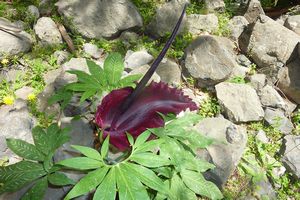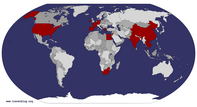Advertisement

 Dragon Arum
Dragon Arum
Common on Samaria Gorge. This striking flower smells like rotting flesh.Crete
Crete is the largest island in Greece and the 2nd largest island in the Mediterranean. It is 160 miles east to west and 37 miles north to south. It has a tremendous amount of history and legends and made a fantastic place to visit.
And the best part was John and I saw it together. John had finished the Camino de Santiago a bit early so we each flew into Athens to meet up. I flew from Santorini and John flew from Santiago de Compostela. After five weeks apart we were both very glad to be traveling together again.
We took a city bus to Piraeus which is the port for Athens and there we caught an overnight ferry to Chania on Crete. Our ship, the Lato, carries 850 vehicles and 2000 passengers. The ship has several bars and different levels of restaurants. A significant number of people were sleeping on the floor in various places on the ship but I think most had cabins. Our cabin had a set of bunk beds, a closet, and a bathroom in about 80 square feet. Unfortunately we were only on board about nine hours and John slept the entire time.

 Venetian Lighthouse
Venetian Lighthouse
A 17th century Venetian lighthouse in Cania Harbor. The scruffy guy in front is John.He was sleep deprived from the Camino but that is another blog entry.
Chania
At 6am we arrived in Chania. Chania is on the north coast of Crete and is the island’s second biggest city. It has a beautiful waterfront with a lovely harbor and 17th century light house and fort. We stayed in the Venetian Quarter which has narrow lanes sunk into a maze of four and five story buildings. It was a nice city to just wander and people watch.
Transliteration
Transliteration is when you take a foreign word (in this case Greek) and spell it using English letters. It can be challenging and there often is not a standard. For instance, this town, in Greek, is XANIA. In English the most common spelling is Chania but our guidebook spells it Hania and I have also seen Canea and Cania.
Samaria Gorge
The next day we left Chania early to hike Samaria Gorge. We took the public bus and there were so many people going that there were two busloads. In addition there were many more private buses headed up as well. Our guidebook says that on a summer day, 1000 people will hike this
gorge. There were several hundred today.
The bus ride took just over an hour and we headed way up into the mountains. There is a spine of mountains running the length of Crete that are very high; in fact, several still have patches of snow. The bus took us directly to the trail head at 1,250 meters in altitude (3750 feet) and we started off.
There are four parts to the trail. Part one is the 4 kilometer descent into the gorge. We dropped close to 2000 feet from the rim down to the bottom of the gorge through an endless series of switchbacks on a well-maintained trail. The vegetation looked very similar to Colorado and had a lot of trees that provided much needed shade. There were a lot of birds and the bird song was very pleasant. Every few kilometers there was a spring with safe drinking water and a rest area with toilets. Bathrooms are essential with this many people
Part two started at the bottom of the gorge. It ran about three kilometers staying near the streambed. When we first reached the bottom the stream was dry. The water appeared a kilometer or

 Cliff Tree
Cliff Tree
A tree growing out of a sheer cliff in Samaria Gorge.so along then disappeared again after a couple of kilometers only to reappear again near the end. This part of the gorge was wooded with the stream cascading from pool to pool (where it was above ground). It was a cool walk in a lovely forest next to a babbling brook.
Part two of the trail ended where the stream disappeared underground again at the settlement of Samaria. The settlement was nationalized when this became Samaria National Park in 1962 and the people were relocated. Now the former town is a lovely rest area and a place for the rangers to live.
Part three of the trail is the part of the trail for which Samaria Gorge is justifiably famous. It is an open, narrow gorge with strikingly tall cliffs on either side. The most famous part of the gorge is the stretch known as the Iron Gates, where the sides of the gorge close in to a width of only four meters (12 feet) and soar up to a height of 1,100m (3,610feet). The upper section is dry but the stream re-appears after awhile. Most of this section is spent walking on the rocks in the streambed

 Iron Gates
Iron Gates
The narrowest part of the Gorge.and it is slow going picking your way down. There are temporary wooden bridges wherever the trail crosses the stream which happens quite regularly.
At the narrowest part of the gorge the wind was really blowing hard and we could see hundreds of bees trying to fly in the gale or resting on the rocks waiting for the wind to die down. In addition, there are often full size trees growing out of the sheer cliff face. It was very beautiful and made the walk worth it.
Part four was the last two kilometers and was just a road walk into town. The total distance is 16 kilometers (10 miles) and we dropped 1250 meters (3750 feet) in altitude.
Once we reached town we bought boat tickets then had two hours to wait. The town’s purpose (now) is to be the terminus for the trail. It has ferries twice a day and several restaurants in which to wait. We found a restaurant by the water and got a snack including two large beers.
We took the ferry to Hora Sfakion and decided to spend the night in this small town on the south coast of Crete

 Hora Sfakion
Hora Sfakion
The beach at Hora Sfakion on the south coast of Crete.rather than return directly to Chania. We had had enough walking so we spent most of the evening sitting in a restaurant watching the sunset and drinking ouzo. It’s a hard life….
Iraklio
The next day we took a bus to Chania then another bus to Iraklio. Iraklio is the largest city on Crete and has history dating back several thousand years. Unfortunately it was badly bombed during WWII so much of the main city is pretty new.
The highlight of a visit to Iraklio is Knossos. Knossos was a palace complex of the Minoan civilization built originally in the 17th century BCE. It is the fabled home of King Minos and the Minotaur. It was excavated in the early 20th century by Sir Arthur Evans of Great Britain. He not only excavated but restored parts of several buildings to suit his interpretation of the ruins. His efforts are very controversial and I am of two minds. They did make the site much more interesting since all of the good finds have been moved to the Archeological Museum in Iraklio. He did not, however, make an effort to distinguish his interpretation from the actual finds so it

 Knossos Column
Knossos Column
As restored by Sir Arthur Evans.is very hard to tell what is original and what is Evan's interpretation. For instance, he re-built several columns that tapered at the bottom and painted them a brick red but I never saw an original column so I don’t know if the shape and color are based on science or imagination.
We spent about two hours at the site then took the bus back to town and visited the Archeological Museum. It was being remodeled so we saw a small temporary exhibit along with several hundred other people. It was very crowded with school groups, tour groups and individuals. But it was well done and we saw many things discovered in the ruins at Knossos and three other Minoan palace ruins. I liked the gold jewelry, especially a bee pendent which was in fantastic shape after 3500 years. It also covered the area from Neolithic through modern times at these sites so there was a good assortment of artifacts.
Next we went to the Historical Museum of Crete. It covered Cretan history from Neolithic age until WWII. I especially appreciated learning about the impact of WWII on Crete including the resistance movement. Sadly, the Nazi brutality was

 Sunset
Sunset
Our last sunset in Greece.not limited to Northern Europe.
We left late that evening to fly to Ireland. When we went through immigration, the officer counted the days and chastised us for cutting it so close. As Americans we are allowed to stay 90 days without obtaining a residency permit. Our flight left at 11:30pm on day 90. I thought it was good planning but he seemed to think we were scatter-brained and just got lucky.
Greece in Summary
As I introduced John to Greece I realized that I really like Greece. The people were friendly, the food delicious, the sights worthwhile and the vibe relaxed. There is so much history here that one could spend months. The islands beckon to come explore one more cove. The religion is similar enough to be understandable and different enough to be intriguing. Greece has made the list of “Places We Will Go Back To” and, trust me, that is a very short list.
Advertisement
Tot: 0.148s; Tpl: 0.013s; cc: 10; qc: 48; dbt: 0.06s; 1; m:domysql w:travelblog (10.17.0.13); sld: 1;
; mem: 1.2mb














Ling Li
non-member comment
Greece
Greece really sounds like a fascinating country with such diversity. I hope to visit one day and would have to allow plenty of time. Hiking Samaria Gorge sounds amazing! Love the sunset!